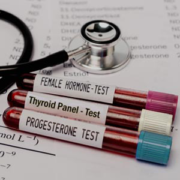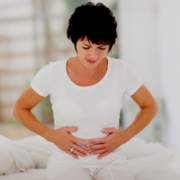Endometriosis
Women with this condition have tissue from the uterine lining that implants itself in places other than the uterus. The reproductive hormones in a woman’s body are believed to increase the growth of endometriosis when it occurs. This can cause a wide variety of symptoms including:
- Intense menstrual cramps
- Painful intercourse
- Infertility
- Excessive bleeding during menses
- Chronic pelvic or low back pain
- Spotting in between periods
- Gut pain
- Fatigue or low fever
- Painful urination or bowel movements during your menstrual periods
- Diarrhea, constipation, bloating, nausea, dizziness, or headaches during periods
- Low resistance to infection
How To Diagnose?
The diagnosis of endometriosis is generally quite difficult. In combination with the symptoms above, if you notice these fertility issues, you should be tested.
- A luteal phase that is normal in length but shows low body temperatures indicating lower than normal progesterone levels during the luteal phase.
- Short cycles (<27 days) with long periods (>8 days).
- Almost no days of wet cervical fluid or even dry days during the cycle.
The “golden standard” is laparoscopy (microscopic examination of the tissue). A “near-contact” laparoscopy is best because tiny endometrial cells can often only be seen at a greatly magnified level. Women with endometriosis may want to consider trying to conceive earlier vs later in their life because this condition is difficult to treat and outcomes of treatment are unpredictable.
How To Treat?
There are a few available treatments for endometriosis, but unfortunately, remission is rarely permanent after medical treatment and it should always be personalized because of the number of variables associated with endometriosis.
- Nonsteroidal anti-inflammatory drugs can reduce pain but have no effect on reducing the endometriosis itself.
- Hormonal birth control can reduce the production of hormones in a woman’s body preventing ovulation and pregnancy, and thus the growth of endometriosis. Birth control pills can also decrease the bleeding that may cause pain. Logically, birth control pills can be used by women with endometriosis pre or post-pregnancy but cannot be used while a woman is trying to get pregnant.
- Gonadotropin releasing hormone agonists. This treatment reduces a woman’s reproductive hormones essentially putting a woman into menopause while taking them. Examples of these medications include nafarelin (Synarel), leuprolide (Lupron), goserelin (Zoladex), or danazol (Danocrine). Because this treatment essentially creates menopause, all of the symptoms of menopause can occur with this treatment- hot flashes, night sweats, vaginal dryness, sleep disturbance, and decreased libido. This treatment cannot be used by a woman trying to get pregnant.
- Laparoscopic Surgery. This should be considered when the above measures have failed and symptoms are unrelenting and severe. Treatment to destroy endometriosis may be performed during laparoscopy by a physician skilled in this procedure to lessen the risks of scarring. This procedure should be performed before ovulation in a woman’s cycle if at all possible as this is believed to lessen the chance of recurrence of endometriosis after treatment.
Excessive Prolactin (Hyperprolactinemia)
While women are breastfeeding, the prolactin hormone is released, which suppresses follicle-stimulating hormone (FSH) and luteal hormone (LH) both of which are vital for ovulation. When ovulation is suppressed, reproductive hormone levels are low and women have minimal or no fertile cervical fluid. Women who constantly breastfeed could go for long periods of time without ovulating. Nature knows best- it prevents future pregnancy and it allows the mother to focus on the nourishment and care of her newborn child before conceiving again while she is breastfeeding. In rare cases, a woman can have a small and usually benign tumor of the pituitary which produces prolactin- the same hormone produced while breastfeeding. It is possible for these women to have irregular or no cycles as well as difficulty getting pregnant. Checking prolactin levels should be part of the evaluation for all women having difficulty getting pregnant.
Avoid Female Surgery
One of the quickest ways to decrease fertility is to have female surgery which can disrupt the health and ability of the ovaries to produce healthy eggs. If female surgery is needed, it should be performed by an experienced physician with the protection of the outer shell of the ovaries where mature eggs are released.
Primary Ovarian Insufficiency (POI)
POI or Premature Menopause is a condition in which lower than normal estrogen production can mimic perimenopause with irregular cycles, hot flashes, vaginal dryness, and painful intercourse. POI is a serious disorder that should be addressed with estrogen-progestin therapy to avoid further health problems including osteoporosis and heart disease. With this endocrine condition, women with POI are unlikely to get pregnant naturally. With the support of integrative therapies, women are at times again to regain healthy ovarian function which may allow pregnancy to occur. Traditional physicians will often recommend donor eggs for women with this condition when they want to get pregnant.
Ovarian Cysts
Ovarian cysts usually don’t cause a serious health risk, and in most cases, they resolve themselves. If they cause pain due to swelling, rupturing, or bleeding, surgery may be required. However, surgery should be a last resort as it can affect fertility due to scarring.
Functional cysts are a result of a normally functioning cycle gone slightly off course. These may occur one time, or occur often and include:
Follicular Cyst
This type of cyst is caused by a follicle surrounding the egg that continues to grow, but instead of rupturing to release the egg it continues to enlarge with the egg still inside – in turn, causing anovulation. When charting, your body may still produce the cervical fluid necessary to conceive, but you will not see the temperature shift that usually happens with ovulation. Follicular cysts usually resolve on their own by day 5 of your next cycle. When follicular cysts are painful, they can be treated with a progesterone injection which will lead to a menstrual period starting within 3-6 days.
Luteinized Unruptured Follicle (LUF)
This cyst is caused by a normal sequence of ovulatory events that come to a halt when the egg remains stuck in the follicle that is supposed to release it. With charting, LUF can be deceptive because fertile-quality cervical fluid is produced and is accompanied by the temperature shift that accompanies ovulation. LUF can lead some women to believe they’re pregnant with a delay in bleeding. Taking an HCG blood test will help to clarify the situation when the test returns a negative result. Just as with Follicular Cysts, they usually resolve on their own by day 5 of your next cycle. If it does not resolve, it can be treated with a progesterone injection.
Corpus Luteum Cyst (CL)
This kind of cyst is caused by the normal formation of a corpus luteum following ovulation. However, instead of the corpus luteum degenerating within 12-16 days as it normally does, it begins to seal off and fill with excess fluid or blood, causing a cyst. With charting, this type of cyst will lead to fertile-quality cervical fluid and is often still accompanied by the temperature shift that accompanies ovulation. A CL cyst, however, may delay your period, which may not come until the cyst resolves itself. In case you got pregnant, the cyst will resolve on its own within the first 3 months of pregnancy.






